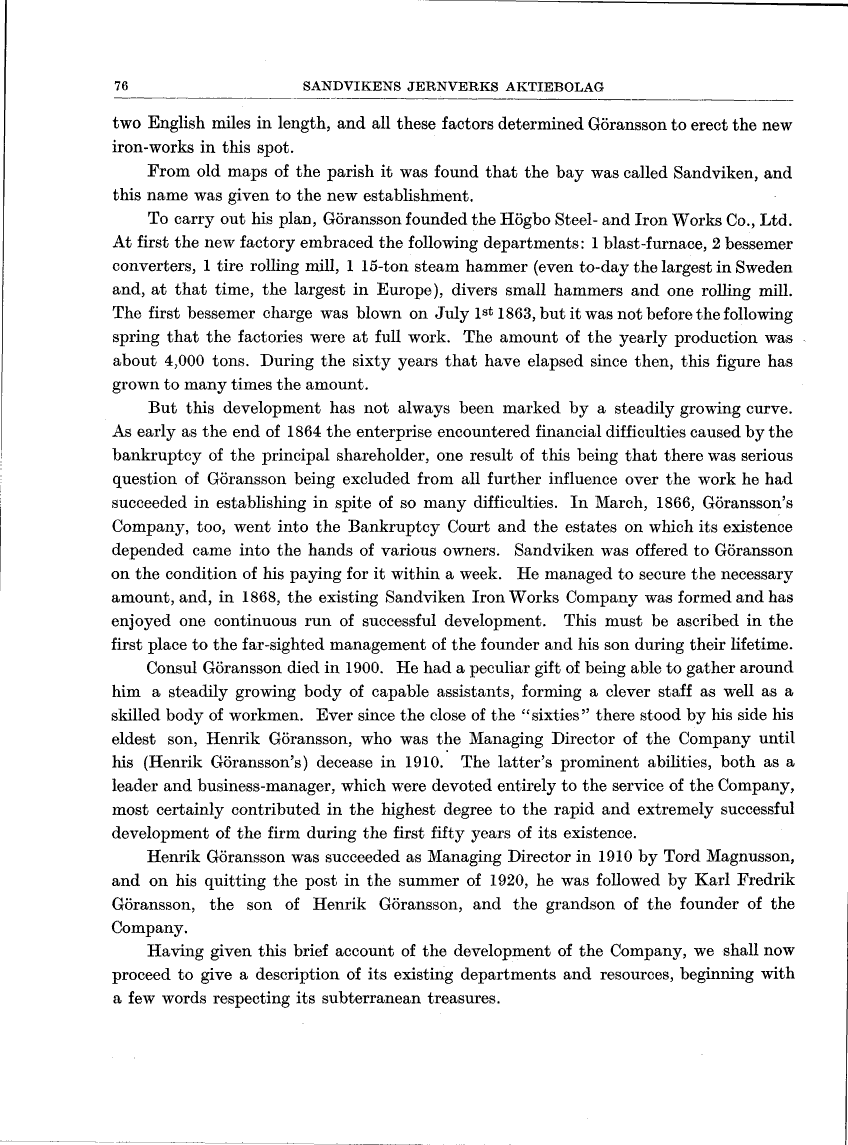
Full resolution (TIFF) - On this page / på denna sida - Sandvikens Jernverks Aktiebolag

<< prev. page << föreg. sida << >> nästa sida >> next page >>
Below is the raw OCR text
from the above scanned image.
Do you see an error? Proofread the page now!
Här nedan syns maskintolkade texten från faksimilbilden ovan.
Ser du något fel? Korrekturläs sidan nu!
This page has been proofread at least once.
(diff)
(history)
Denna sida har korrekturlästs minst en gång.
(skillnad)
(historik)
two English miles in length, and all these factors determined Göransson to erect the new
iron-works in this spot.
From old maps of the parish it was found that the bay was called Sandviken, and
this name was given to the new establishment.
To carry out his plan, Göransson founded the Högbo Steel- and Iron Works Co., Ltd.
At first the new factory embraced the following departments: 1 blast-furnace, 2 bessemer
converters, 1 tire rolling mill, 1 15-ton steam hammer (even to-day the largest in Sweden
and, at that time, the largest in Europe), divers small hammers and one rolling mill.
The first bessemer charge was blown on July 1st 1863, but it was not before the following
spring that the factories were at full work. The amount of the yearly production was
about 4,000 tons. During the sixty years that have elapsed since then, this figure has
grown to many times the amount.
But this development has not always been marked by a steadily growing curve.
As early as the end of 1864 the enterprise encountered financial difficulties caused by the
bankruptcy of the principal shareholder, one result of this being that there was serious
question of Göransson being excluded from all further influence over the work he had
succeeded in establishing in spite of so many difficulties. In March, 1866, Goransson’s
Company, too, went into the Bankruptcy Court and the estates on which its existence
depended came into the hands of various owners. Sandviken was offered to Göransson
on the condition of his paying for it within a week. He managed to secure the necessary
amount, and, in 1868, the existing Sandviken Iron Works Company was formed and has
enjoyed one continuous run of successful development. This must be ascribed in the
first place to the far-sighted management of the founder and his son during their lifetime.
Consul Göransson died in 1900. He had a peculiar gift of being able to gather around
him a steadily growing body of capable assistants, forming a clever staff as well as a
skilled body of workmen. Ever since the close of the "sixties" there stood by his side his
eldest son, Henrik Göransson, who was the Managing Director of the Company until
his (Henrik Göransson’s) decease in 1910. The latter’s prominent abilities, both as a
leader and business-manager, which were devoted entirely to the service of the Company,
most certainly contributed in the highest degree to the rapid and extremely successful
development of the firm during the first fifty years of its existence.
Henrik Göransson was succeeded as Managing Director in 1910 by Tord Magnusson,
and on his quitting the post in the summer of 1920, he was followed by Karl Fredrik
Göransson, the son of Henrik Göransson, and the grandson of the founder of the
Company.
Having given this brief account of the development of the Company, we shall now
proceed to give a description of its existing departments and resources, beginning with
a few words respecting its subterranean treasures.
<< prev. page << föreg. sida << >> nästa sida >> next page >>